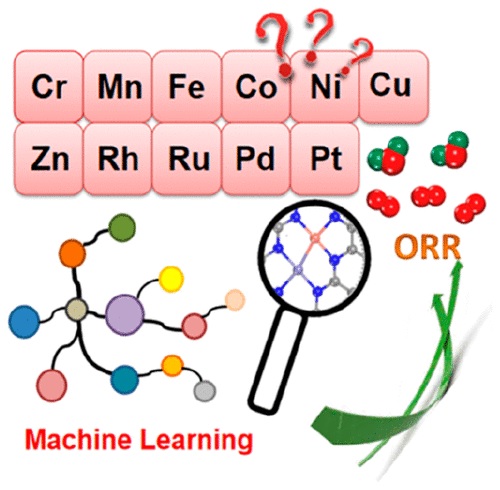李亚飞教授课题组在JOURNAL OF PHYSICAL CHEMISTRY LETTERS发表研究论文
Activity Origin and Design Principles for Oxygen Reduction on Dual-Metal-Site Catalysts: A Combined Density Functional Theory and Machine Learning Study
Zhu, XR (Zhu, Xiaorong)[ 1 ] ; Yan, JX (Yan, Jiaxian)[ 2 ] ; Gu, M (Gu, Min)[ 3 ] ; Liu, TY (Liu, Tianyang)[ 1 ] ; Dai, YF (Dai, Yafei)[ 2 ]*; Gu, YH (Gu, Yanhui)[ 3 ]*; Li, YF (Li, Yafei)[ 1 ]*(李亚飞)
[ 1 ] Nanjing Normal Univ, Jiangsu Collaborat Innovat Ctr Biomed Funct Mat, Sch Chem & Mat Sci, Jiangsu Key Lab New Power Batteries, Nanjing 210023, Jiangsu, Peoples R China
[ 2 ] Nanjing Normal Univ, Sch Phys Sci & Technol, Nanjing 210023, Jiangsu, Peoples R China
[ 3 ] Nanjing Normal Univ, Sch Comp Sci & Technol, Nanjing 210023, Jiangsu, Peoples R China
JOURNAL OF PHYSICAL CHEMISTRY LETTERS,201912,10(24), 7760-7766
Dual-metal-site catalysts (DMSCs) are emerging as a new frontier in the field of oxygen reduction reaction (ORR). However, there is a lack of design principles to provide a universal description of the relationship between intrinsic properties of DMSCs and the catalytic activity. Here, we identify the origin of ORR activity and unveil design principles for graphene-based DMSCs by means of density functional theory computations and machine learning (ML). Our results indicate that several experimentally unexplored DMSCs can show outstanding ORR activity surpassing that of platinum. Remarkably, our ML study reveals that the ORR activity of DMSCs is intrinsically governed by some fundamental factors, such as electron affinity, electronegativity, and radii of the embedded metal atoms. More importantly, we propose predictor equations with acceptable accuracy to quantitatively describe the ORR activity of DMSCs. Our work will accelerate the search for highly active DMSCs for ORR and other electrochemical reactions.

文章链接:
https://pubs.acs.org/doi/10.1021/acs.jpclett.9b03392
版权与免责声明:本网页的内容由收集互联网上公开发布的信息整理获得。目的在于传递信息及分享,并不意味着赞同其观点或证实其真实性,也不构成其他建议。仅提供交流平台,不为其版权负责。如涉及侵权,请联系我们及时修改或删除。邮箱:sales@allpeptide.com